How did Leonardo da Vinci die?
Leonardo da Vinci died on May 2, 1519, at the age of 67 at Le Clos Lucé Castle in Amboise, France. It is assumed that he died of a stroke, but the actual cause of death is unknown. His death probably did not come as a surprise, as he had drawn up his will a week earlier.
How was Leonardo buried?
Leonardo specified in his will how he wanted to be buried. On the day of the funeral, three large and thirty silent masses were held in the four churches of Amboise. The funeral procession led from Leonardo's chateau, Le Clos Lucé, to the cemetery of the church of Saint-Florentin at the chateau of Amboise. Leonardo's coffin was carried by the priests of the Church of Saint-Florentin. He was accompanied by clergymen of the four churches, as well as by 60 paupers, each carrying a large candle. The 60 candles were then distributed among the four churches.
Where is Leonardo da Vinci buried?
Leonardo da Vinci was buried in the cloister of the church of Saint-Florentin in Amboise. The tomb was destroyed during the Huguenot Wars (1562-1598). Leonardo's remains were considered lost since then. Later excavation work on the church grounds uncovered bones believed to be Leonardo's remains. These were moved to the Hubertus Chapel of Amboise Castle, where Leonardo's presumed grave is located today.
Who inherited Leonardo's property?
Leonardo's considerable fortune was divided among his half-brothers, the two pupils Francesco Melzi and Salai, as well as his servant Vilanis and his maid. They inherited gold, land, utensils, furniture and clothes. The paintings from Leonardo's estate probably went to Salai and, after his death, to the French king. Leonardo's notebooks went to Francesco Melzi.
Leonardo in France
Leonardo spent almost his entire life in Northern Italy, primarily in the two cities of Florence and Milan, and later three years in Rome. It may be surprising from today's perspective that Leonardo left Italy to spend the last three years of his life in France. However, Leonardo had lived for about 25 years in the Duchy of Milan. Due to the geographical proximity to France and numerous diplomatic contacts, Leonardo had been in touch with the French royal court for quite some time and had many admirers there.
Influential Admirers of Leonardo
Anne of Brittany, Queen of France
Anne of Brittany was the last ruler of the previously independent Duchy of Brittany in the far northwest of France and was a subject of political marriages throughout her life. She initially married the German Emperor Maximilian I in 1490. Under pressure from the French King Charles VIII, the marriage was soon annulled so that Charles VIII could marry Anne himself and thereby gain control over Brittany. In the meantime, the heavily indebted Emperor Maximilian I had married Bianca Maria Sforza in 1494, who was the niece of Leonardo's longtime patron, Ludovico Sforza, the Duke of Milan. Along with a substantial dowry, Bianca likely brought Leonardo's painting "Madonna of the Rocks" into the marriage, which Ludovico had previously acquired from Leonardo.
"He [Leonardo] painted an altarpiece for Ludovico, the ruler of Milan, and all who have seen the painting consider it one of the most beautiful and unusual works that can be found in painting. It was sent from said Duke to the Emperor in Germany." (Codex Magliabechiano)
It becomes evident how closely intertwined the German imperial house, the French royal house, and the court of Milan were during Leonardo's lifetime. When the French King Charles VIII tragically died in an accident at Château d'Amboise in 1498 (he had hit his head), Anne of Brittany married his cousin and successor Louis XII and became Queen of France once again. She died in 1514, two years before Leonardo came to France. However, she had been in contact with Leonardo before and was likely the patroness of Leonardo's painting "The Virgin and Child with St. Anne" around 1501.
Louis XII, King of France
In 1498, Leonardo completed his largest painting by far, the famous "Last Supper" on a wall of the Santa Maria delle Grazie monastery in Milan. A year later, Louis XII conquered Milan and ousted Leonardo's longtime patron, Duke Ludovico Sforza. The French King was reportedly so impressed by Leonardo's "Last Supper" that he inquired whether the nine-meter-wide painting and the wall could be transported to France. However, this proved to be unfeasible, and the "Last Supper" remained in Milan. In 1507, when Leonardo and his brothers were in a dispute over the inheritance of their deceased uncle Francesco, the King personally advocated for Leonardo and sent relevant letters to the city government of Florence.
Florimond I. Robertet, Secretary and Treasurer of the French King
Around the same time, around 1501, Leonardo's workshop created two versions of a painting "Madonna of the Spindle" intended for the secretary and treasurer Florimond I. Robertet, at that time one of the wealthiest and most influential men in France.
Charles II d'Amboise, French Governor of Milan
After the French conquered Milan in 1499, Leonardo worked for the French Governor of Milan, Charles II d'Amboise, from 1506 to 1512. During this time, he and the French King exerted pressure on the city government of Florence when Leonardo was being cheated out of his inheritance by his brothers.
Francis I, King of France
In January 1515, at the age of 20, Francis I became the King of France. In the same month, Leonardo's patron Giuliano di Lorenzo de' Medici married the king's aunt. It is highly likely that Leonardo's famous mechanical lion, which could walk a few steps on its own, was presented on the occasion of this wedding. Leonardo himself was not present at the wedding. In December 1515, the Medici Pope Leo X, accompanied by a large entourage that included Leonardo, went first to Florence and then to Bologna. It's likely that this is when Francis I and Leonardo met in person for the first time. After the early death of Giuliano di Lorenzo de' Medici, Francis I became Leonardo's new and final patron in the fall of the following year.
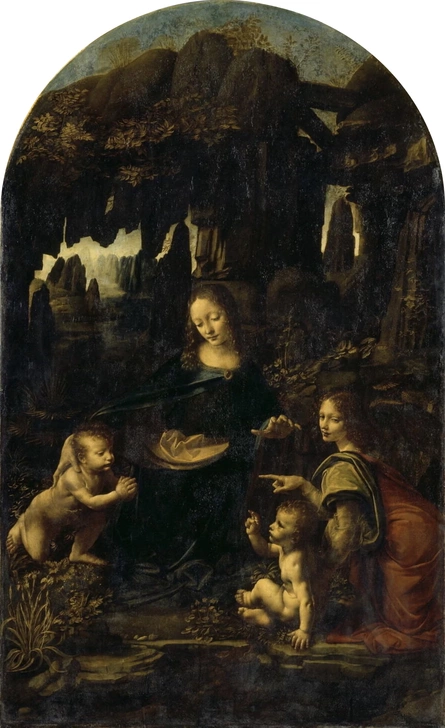
The painting probably went to Germany in connection with the marriage of Ludovico Sforza's niece to the German emperor around 1494, as the anonymous Codex Magliabechiano reports
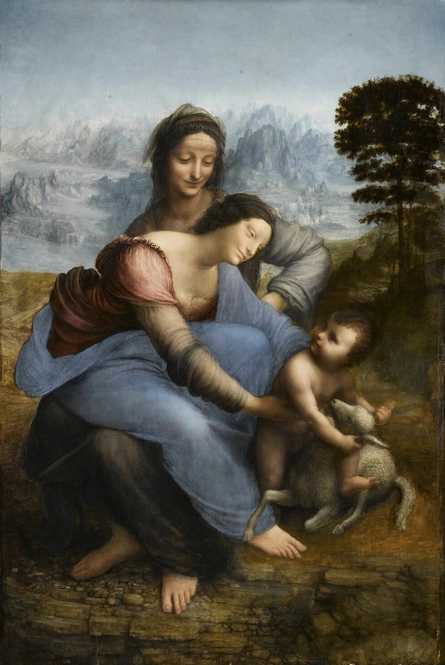
It is probable that Leonardo made the painting for the French queen Anne de Bretagne
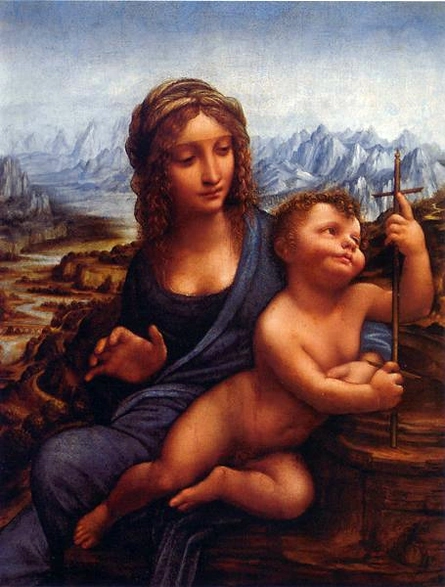
A contemporary correspondence shows that Leonardo's workshop made this painting for the French treasurer Florimond I. Robertet
First painter, engineer and architect of the king
After the unexpected death of Leonardo's patron Giuliano di Lorenzo de' Medici in March 1516, Leonardo accepted an invitation from the French King Francis I in the summer of 1516 and left the papal court in Rome with his students Francesco Melzi and Salai and went to France, to the royal court in Amboise.
Amboise Castle
Francis I was one of the so-called Loire kings. During the Hundred Years' War between France and England (1337-1453), the French capital was occupied by English forces in 1420-1436. As a result, the French kings retreated to the Loire Valley in western France and organized resistance from there. Amboise Castle and Blois Castle, about 30 km away, were henceforth the preferred residences of the French kings. It was not until the reign of Francis I in 1528 that Paris again became the royal capital and the castles on the Loire lost their former importance.
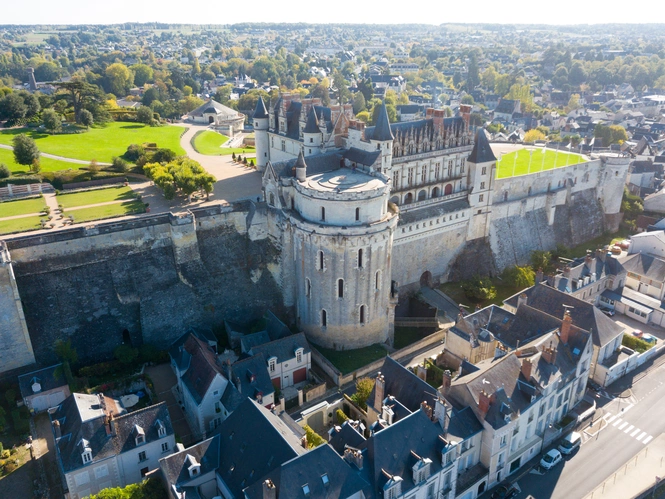
Amboise Castle is located on a hill in the center of the village of Amboise, about 200 km southwest of Paris
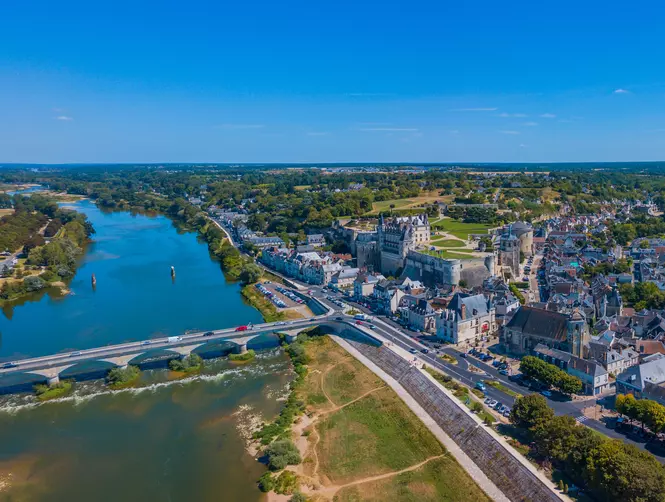
The light area at the upper right edge of the picture is the sandy area in the courtyard of Le Clos Lucé castle
Castle Le Clos Lucé
Although Leonardo was highly respected at the French court, his annual salary of 1,000 ducats was only half of what the Duke of Milan had once paid him. Presumably this was for reasons of court policy. The king's highest official received the same salary. Therefore, Leonardo, a foreigner and a painter at that, that is, according to the understanding of the time, only a craftsman, could not be paid a higher salary, because that would probably have led to unrest at court. Therefore, probably as an additional privilege, Leonardo was given the nearby castle of Cloux, which today is called the castle of Le Clos Lucé. It is only about 500m away from Amboise Castle. The two castles are connected by a tunnel, which is said to have been used by the French King Francis I to visit Leonardo for private talks. The castle is still preserved and can be visited.
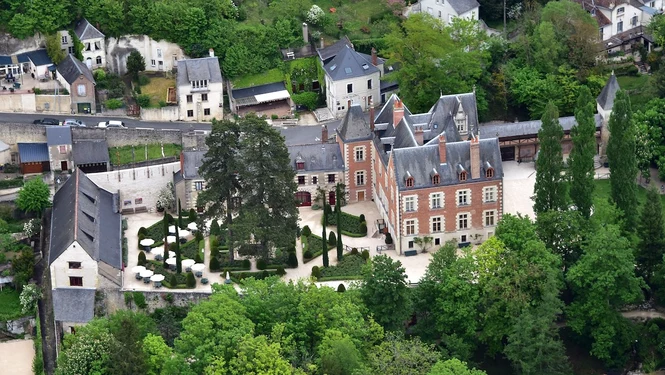
The building now houses a Leonardo museum, where some replicas of his inventions can be seen. After the legendary performance in Milan, Leonardo staged his famous Paradise Festival in the garden of the castle a second time
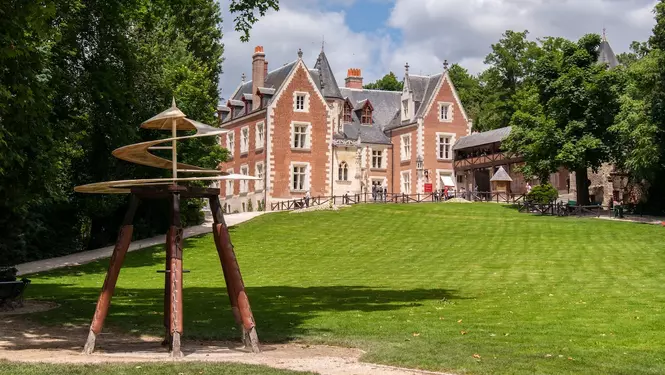
On the left is a variant of the flying propeller Leonardo wanted to use for his invention of a helicopter
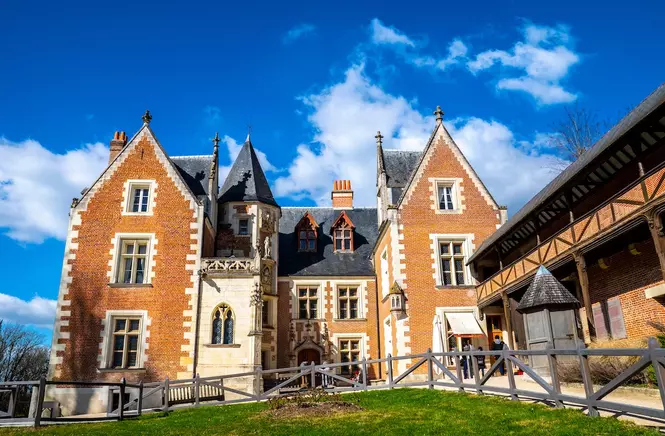
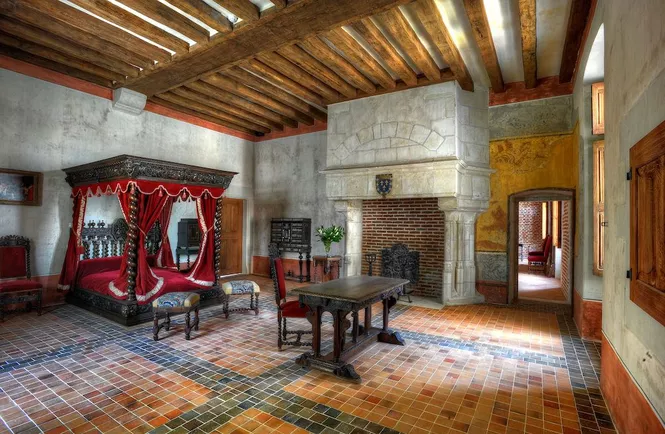
The castles on the Loire
Amboise is located on the idyllic Loire River, which was heavily fortified during the Hundred Years War between England and France (1337-1453). There were about 40 major castles along the Loire, which were no longer needed after the English were expelled from France. Wealthy courtiers had already begun to demolish the old castles in the 1490s and build magnificent chateaux on the foundations.
In the competition for the most magnificent of the castles on the Loire, Leonardo's main task was to advise and plan the French King Francis I's own representative buildings. The king was particularly interested in the remodeling of Romorantin Castle, Blois Castle and Chambord Castle. The hunting lodge at Chambord was Francis I's favorite project and is today considered the most magnificent of the Loire castles.
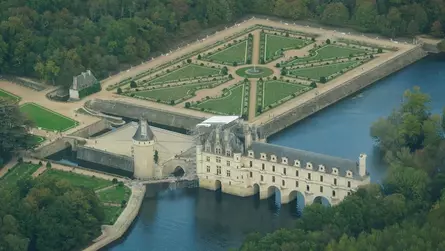
The stone square with the tower is a remnant of the former castle.The first builder was a high financial official of the king, Thomas Bohier.The inhabitable bridge over the Cher (a tributary of the Loire) was only built around 1570 by the French Queen Catherine de' Medici. It is the only castle in Europe that was built completely over a body of water
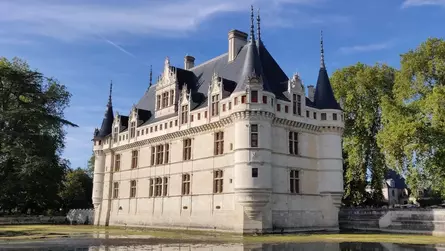
Located on a small tributary of the Loire River, the former castle was demolished and replaced by a chateau.The builder was a high financial official of the king, Martin Berthelot
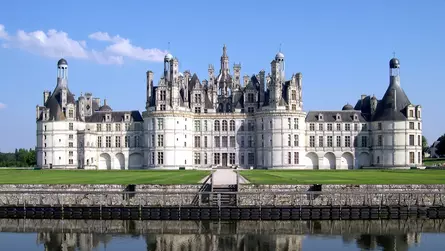
The two middle towers stand on the foundations of the earlier castle.The magnificent hunting lodge of Francis I goes back to Leonardo's plans. It is surrounded by the largest walled outdoor enclosure in Europe.Chambord was the favorite project of the French king
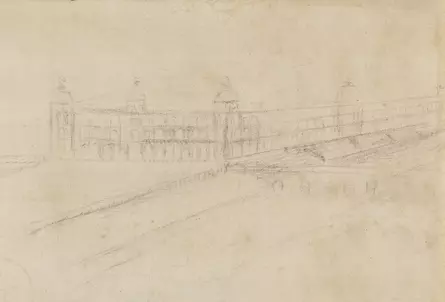
Due to Leonardo's early death, there are only first sketches of the castle. If it had been built, it would have had the dimensions of the Palace of Versailles
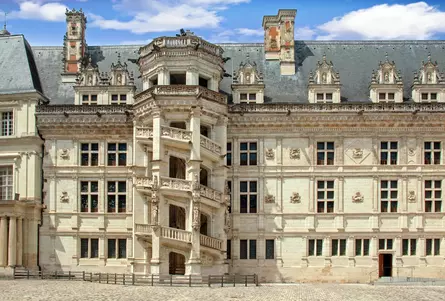
Francis I had this part of the building added to the existing chateau starting in 1515. The characteristic spiral staircase shows parallels to the famous staircase in Chambord. The French queen Caterina de' Medici died in this part of the castle
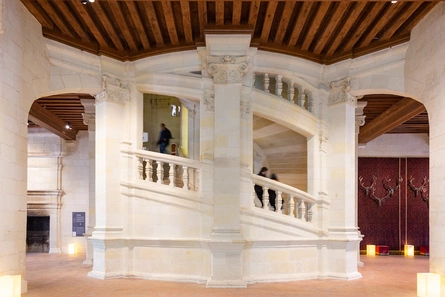
The staircase goes back to a design by Leonardo. It is the first double-flight staircase in the history of architecture, i.e. two flights of stairs run around a central core without touching each other. The staircase thus has the shape of a double helix
Further tasks of Leonardo at the French court
In France, Leonardo worked not only as an architect and engineer for the king.He was also the creative head of courtly celebrations on public occasions. He re-enacted the famous Paradise Festival, which he had organized for the court of Milan more than 20 years earlier, at the request of the French king. Leonardo also oversaw a sewerage project in Sologne. Finally, Leonardo continued to work on some of his famous paintings during this period. The last eyewitness account by Antonio de Beatis, dated 1517, mentions four of Leonardo's paintings that he saw while visiting the French royal court.
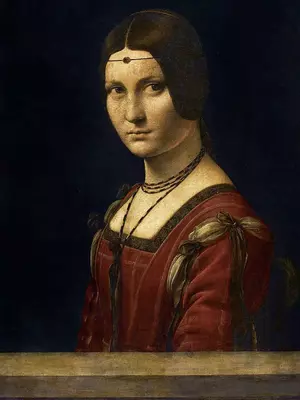
Probably the "Lady from Milan" of the travelogue by Antonio de Beatis
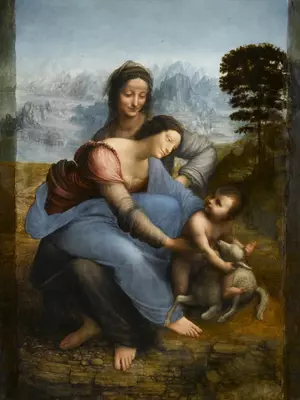
Antonio de Beatis also reports of "the Madonna and her son being placed in the lap of St. Anne"
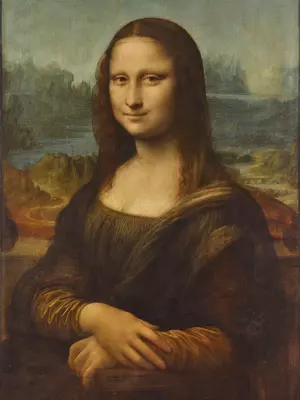
Antonio de Beatis calls her the "certain Florentine"
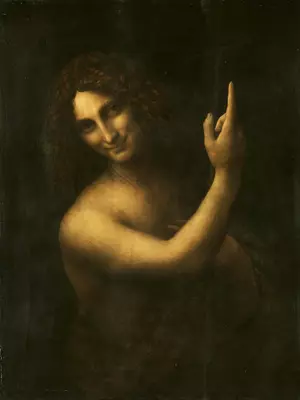
This painting also mentions Antonio de Beatis. It is probably Leonardo's last painting, which he had probably begun while still in Rome
Leonardo's state of health around 1516
Very little is known about Leonardo's last three years in France. It is often mentioned in literature that Leonardo was already very frail by that time. A series of strokes is said to have caused paralysis. However, given the many activities Leonardo was engaged in during this period, this portrayal seems less credible.
In this context, it's important to know that all speculations about possible age-related ailments of Leonardo are based solely on two historical sources. Both sources, however, provide very sparse information and are open to varied interpretation. One is a letter from Leonardo dated 1515 to his patron Giuliano di Lorenzo de' Medici in Rome, the brother of Pope Leo X. The other is the travel report of Antonio de Beatis, which serves as the last source reporting on the still-living Leonardo.
The Letter to Giuliano di Lorenzo de' Medici
In Leonardo's notebooks, a draft of a letter to his patron Giuliano de' Medici is preserved, dated 1515. Giuliano had suffered from a bout of consumption (tuberculosis), and Leonardo begins a letter to him with:
"Regarding the longed-for restoration of Your health, illustrious Sir, I have rejoiced so much that my disease has almost left me." (Codex Atlanticus, folio 671)
However, the sentence can also be translated as:
"I have rejoiced so much, Your Excellency, that you have regained the longed-for health, that it almost made me forget my bad."
In the original, it says at this point "[...], che quasi el mal mio da me s'è fuggito". "Mal mio” has a very general meaning and can refer to something bad, such as evil, illness, misfortune, plague, trouble, adversity, etc. The word also exists in French, where it carries the same meaning.
However, Leonardo does not further address a "disease" in the letter. Instead, he extensively complains to Giuliano about a lazy craftsman who causes him some trouble, in other words, problems, and various minor issues. Thus, the opening sentence of the letter makes more sense when translated as "bad" rather than "disease." Therefore, the limited information in the first sentence of the letter is not evidence of a serious disease of Leonardo.
The Travel Report of Antonio de Beatis
The notion that Leonardo had suffered a series of strokes in France, possibly even earlier in Rome, comes from the travel report of Antonio de Beatis. The complete report of de Beatis' encounter with Leonardo can be read at the end of this page.
Antonio de Beatis was the secretary of Cardinal Luigi d'Aragona. The Cardinal undertook a large-scale diplomatic journey through Western Europe in 1517-1518. He had his secretary, Antonio de Beatis, keep a travel diary during this journey. This travel diary is the last source that reports on the still-living Leonardo.
The Cardinal visited the French King Francis I on October 10, 1517, at Château d'Amboise in France. On that occasion, they also visited Leonardo at the nearby Château du Clos Lucé. Antonio Beatis made a few notes about it. He describes an "elderly Leonardo da Vinci" (Leonardo was only 65 at the time) and notes: "unfortunately, one can no longer expect anything from the master, as his right side is paralyzed." He does not provide further details about Leonardo's health.
Did Leonardo Have a Series of Strokes?
Based on the limited information, it is often inferred that Leonardo must have had one or more strokes, as partial paralysis is a typical symptom of strokes. However, it's overlooked that Leonardo was left-handed and predominantly used his left arm, resulting in noticeably limited use of his right arm. This behavior might have given strangers the impression that Leonardo's right side was paralyzed. Furthermore, it should be noted that even after 1517, the year of de Beatis' visit, Leonardo continued to make entries in his notebook, as dated records from 1518 show. These entries include detailed drawings. Therefore, de Beatis' impression is difficult to reconcile.
Was Leonardo an Old Man?
Against the description of an "elderly Leonardo" as referred to by de Beatis, it's worth noting that at least until mid-1518, Leonardo was actively traveling through the Loire Valley to plan or oversee construction activities. Distances between Amboise, Chambord, Blois, and Romorantin were significant in those times. For the distances of up to 60 kilometers, Leonardo would have required approximately 1-2 days if he traveled by carriage into the partially undeveloped regions. These would have been considerable hardships for an elderly person, especially one who was partially paralyzed.
Leonardo's death
On June 24, 1518, ten months before his death, Leonardo noted that he had left the construction site of the royal palace in Romorantin and was going to Château du Clos Lucé. This is Leonardo's last dated entry. As Leonardo did not date all entries in his notebooks, it cannot be ruled out that he continued to travel through the Loire Valley after June 24, 1518. The date holds significant symbolic value. June 24 is the feast day of Saint John the Baptist, Leonardo's hometown of Florence's highest holiday as St. John is the city's patron saint. Leonardo's last painting is a depiction of St. John the Baptist.
Leonardo da Vinci passed away on May 2, 1519. He was only 67 years old. His death was probably not unexpected, as he had made his will a week prior. There are no contemporary sources providing exact details about the circumstances of his death. Particularly because the roughly 20 years younger Michelangelo was able to reach the advanced age of 88, Leonardo's lifespan is often perceived as too short.
Vasari's Account of Leonardo's Death
Giorgio Vasari was a painter and architect from Florence. He is considered the first art historian and is known today primarily for his biographies of artists. His biography of Leonardo is considered the first comprehensive description of Leonardo's life. However, this biography was written about 30 years after Leonardo's death and first published in 1550. When Leonardo died, Vasari was only seven years old.
"In the end, having become old, he lay ill for many months, and as death approached, he wanted to be instructed with all diligence in the Catholic rite and the true doctrine of the holy Christian religion. He confessed repentantly with many tears, and although he could no longer stand on his feet, he received the holy sacrament outside of bed, supported by the arms of his friends and servants. The king, who visited him often and with affection, came to him shortly afterward. Leonardo raised himself with reverence to sit in bed, described his ailment to him with all circumstances, and complained that he had erred against God and mankind by not having done his duty in his art. This effort brought on a stronger attack that was a harbinger of death. The king rose and held his head to give him aid and favor to alleviate his suffering. Leonardo's divine spirit recognized that he could not be bestowed a greater honor, and he passed away in the arms of the king at the age of 75."
The legend that Leonardo died in the arms of the French King Francis I is attributed to Vasari. On the day of Leonardo's death, Francis I was celebrating the birth of his second son Henri (*March 31, 1519) in Saint-Germain-en-Laye. Vasari's accounts are generally known for containing numerous inaccuracies. Among other errors, Vasari incorrectly states Leonardo's age at the time of death. He lists Leonardo as 75 years old, whereas Leonardo actually passed away at the age of 67. Nonetheless, Vasari's portrayal of Leonardo's life greatly contributed to the legend-building around Leonardo. Many artists and art historians still reference his depictions to this day. The painting "The Death of Leonardo da Vinci" (1818) by the renowned artist Ingres is based on Vasari's account.
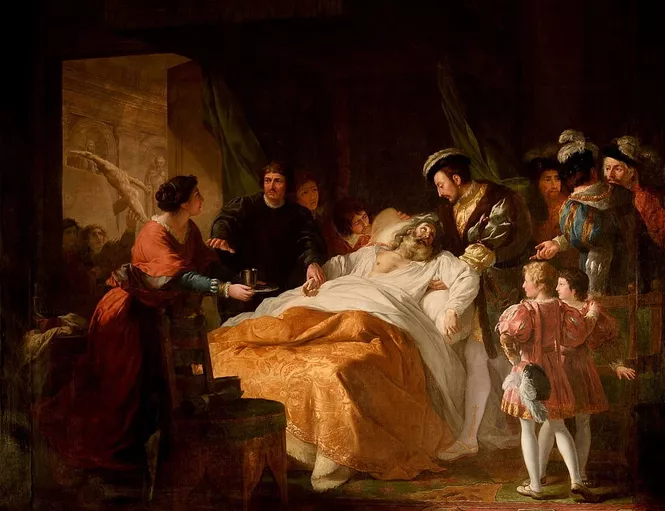
Ménageot was inspired by Vasari's narrative. The painting is now in the Musée de l'Hôtel de Ville in Amboise
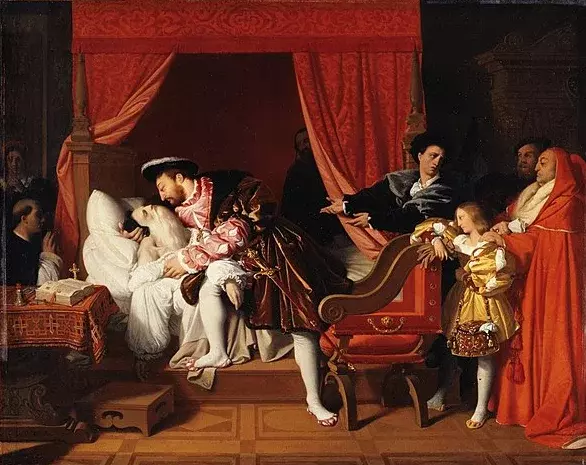
Ingres, like Menageot, was inspired by Vasari's narrative. A copy of the painting can be found today in Leonardo's former bedroom in Le Clos Lucé Castle
Leonardo's Will
About a week before Leonardo's death, on April 23, 1519, the notary Boreau came to Château du Clos Lucé, and Leonardo drafted his will. The complete text of Leonardo's will can be found at the end of this page.
The fact that Leonardo was allowed to make a will, meaning he could determine the fate of his possessions, was only possible due to a special permission from the king. As Leonardo was not a member of the nobility, according to the laws of the time, his entire estate would have gone to the king.
Summary of the Will
The will can be divided into two parts: Leonardo's wishes for his burial and the distribution of his possessions.
Details about the Burial Ceremony
- Leonardo wished to be buried in the Church of Saint-Florentin in Amboise. The church is named after Saint Florentin, and the name Florentin is derived from the Latin verb "florens" (meaning "blooming"), which also relates to Leonardo's hometown of Florence. Florence's emblem is a blooming lily, which was also the emblem of the royal French court
- Before the burial, three solemn and thirty silent masses were held in the four churches of the royal residence in Amboise
- Leonardo's coffin was carried from Château du Clos Lucé to the Church of Saint-Florentin by the chaplains of the church
- The coffin was accompanied by 60 poor individuals, each carrying a large candle, as well as representatives from the Church of Saint-Florentin and dignitaries from the other three churches
- The sixty candles were then divided equally among the four churches of Amboise, resulting in 15 candles per church.
Details about the Inheritance
- Leonardo's student Francesco Melzi (age 28) was named executor of the will. He received Leonardo's notes, books, tools, clothing, as well as outstanding wages and the money present in Château du Clos Lucé
- Leonardo's brothers received his assets in the Florentine bank (400 gold ecus, approximately 1.4 kg of gold)
- His student Salai (around 39 years old) received half of a property near Milan
- His servant Vilanis received the other half, along with the rights to draw water from the navigable canal of St. Christopher in Milan – a right originally granted to Leonardo by King Louis XII – as well as all the furniture and utensils in Château du Clos Lucé.
- His maid Maturina received fine clothing and two ducats (equivalent to about 2-3 months' salary)
- A small sum was also donated to the poor in the vicinity of Amboise (70 soldi = 3.5 Lira, roughly an average monthly salary).
Fate of the Notebooks and Paintings
Leonardo's Notebooks
Most of what is known about Leonardo today comes from his own notebooks, called codices. Francesco Melzi preserved them in his villa near Vaprio d'Adda in Milan. Modern estimates suggest that there could have been up to 20,000 pages, some bound, some individual sheets. Melzi began organizing the vast collection of notes and adding his own annotations. After his death, the collection scattered across Europe. In the 19th century, efforts began to reunite them. Today, the codices are housed in museums in Madrid, London, Paris, Turin, Milan, and Rome. Another is in the possession of entrepreneur Bill Gates (Codex Leicester).
Leonardo's Paintings
From the travel report of Antonio de Beatis, it is evident that some of Leonardo's paintings remained in his possession. These include "La Belle Ferronnière," "Annunciation," "Mona Lisa," and "St. John the Baptist." After Leonardo's death, his paintings were likely in the possession of his student Salai. Salai died in 1524 after an unspecified conflict. His wife Blanca de Anono and his sisters Angelina and Laurentiola disputed his estate afterward. A notarial document shows that the estate primarily consisted of paintings.
From the Notarial Records of Pietro Paolo Crevenna:
"In the name of the Lord, from his birth in the fifteen hundred and twenty-fifth year [1525], the thirtieth announcement, on Friday, April 1. John Jacobus de Caprotis de Oprena, known as Salay, painter until January 29, 1524, died a violent death and left the ladies Angelina and Laurentiola, sisters of Caprotis de Opprena, as his legitimate sisters and heirs in equal parts, and also the lady Blanca de Anono, his lawful wife [...]
1 painting, called Leda, 200 scudi [Leda with the Swan?]
1 painting, called Holy Anna, 100 scudi [Virgin and Child with Saint Anne?]
1 painting, woman slightly turned back, called La Joconde, 100 scudi [Mona Lisa?]
1 large painting with a St. John the Baptist, 80 scudi [Bacchus?]
1 painting with a large St. Jerome, 40 scudi [St. Jerome?]
1 painting with a semi-naked woman, 25 scudi [Monna Vanna?]
1 painting with a semi-naked St. Jerome, 25 scudi [St. Jerome?]
1 small painting with a young St. John, 25 scudi [St. John the Baptist?]
1 painting with a Christ as God the Father, 25 scudi
1 Madonna with her child in her arms, 20 scudi [Madonna with the Spindle?]
1 Christ at the Column, unfinished, 5 scudi
[...]"
Based on their titles, the mentioned paintings could be attributed to Leonardo. The fact that they were valued as commissioned works is noteworthy, as high-quality painters could demand between 100 and 300 scudi, depending on the size of the painting. Paintings or portraits that were not directly commissioned were typically valued much lower.
The circumstances surrounding how these paintings came into the possession of the French king are unknown. It's possible that the originals Leonardo brought to France never left the French royal court, as Salai might have possessed only good copies made by Leonardo's students or possibly even by Leonardo himself.
Leonardo's tomb
Historical sources on Leonardo's funeral are not known. However, it can be assumed that it took place as it was stipulated in Leonardo's will. It is certain that he was buried in the church of Saint-Florentin mentioned there, because in the register of the Royal Chapter of the church of Saint-Florentin the following entry can be found:
"In the cloister of this church was buried: Master Lionard de Vincy, Noble of Milan, first painter, engineer and architect to the King, State Expert of Mechanics and former Director of Painting to the Duke of Milan."
The church of Saint-Florentin has been preserved, but Leonardo's tomb was destroyed during the Huguenot Wars (1562-1598). His remains were considered lost ever since. Later excavation work on the site uncovered human bones believed to be Leonardo's remains. They were transferred to the Chapel of St. Hubert, located on the grounds of the chateau in Amboise. Leonardo's assumed tomb has been opened to the public and can be visited.
A Youtube video shows the interior of the chapel. At the time the video was recorded, there is a large bouquet of white lilies on the right side of the altar. Lilies were the symbol of royal France, and a stylized lily still adorns the coat of arms of Florence, Leonardo's hometown.

The church of Saint-Florentin is at the bottom right of the picture. The cloister under which Leonardo was buried has not been preserved. It belonged to a small monastery that once directly adjoined the church
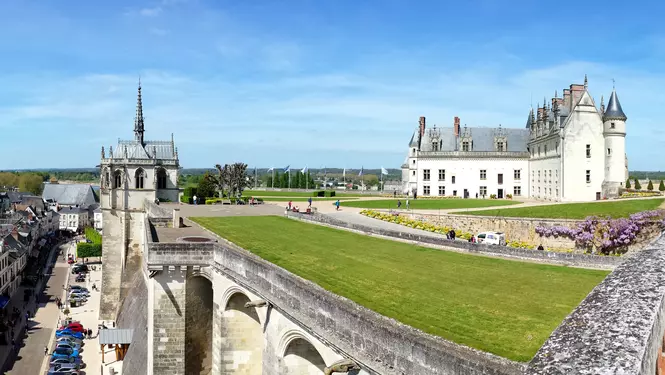
In the Hubertus chapel (left) today are possibly the mortal remains of Leonardo
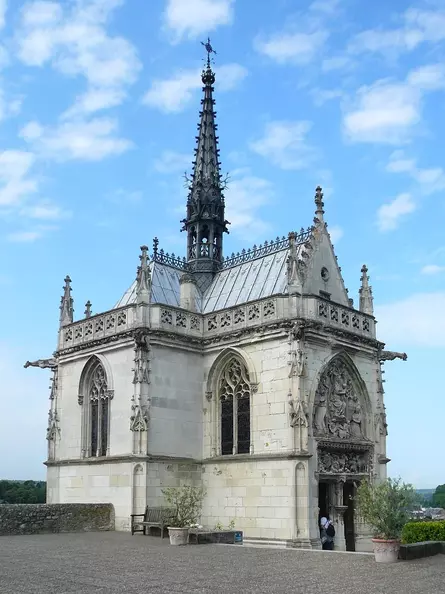
The assumed tomb of Leonardo is located in the left transept of the chapel, or on the right as seen from the altar of the chapel
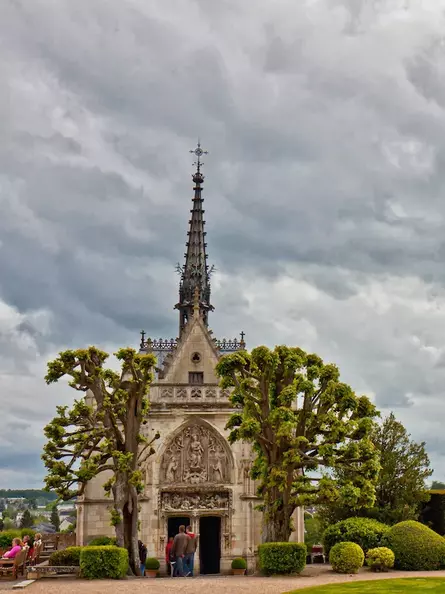
Due to the perspective, the trees appear directly in front of the chapel, but they are several meters in front of it
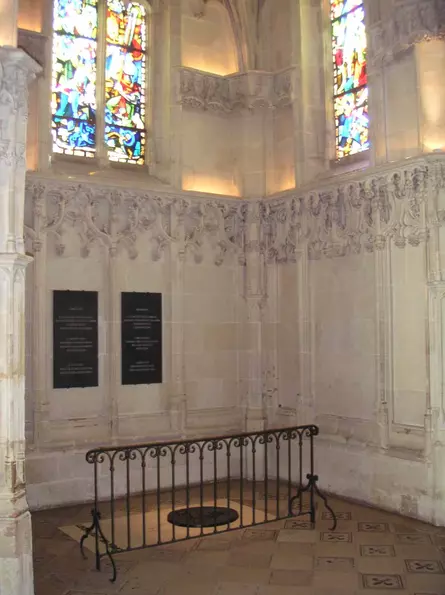
It is possible that Leonardo's mortal remains are under the tomb slab.On the wall above are two memorial plaques, one in French, the other in Italian.The floor of the chapel is decorated with lilies, the symbol of both royal France and Florence
His death caused the greatest sadness to all who had known him. Never had painting been more honored by an artist.
Original texts
Original text from Antonio de Beatis's travel report
"In one of the districts, my lord and the rest of us went to see the Florentine Leonardo Vinci, more than 70 years old [here the scribe errs, as Leonardo was 65 at that time], an outstanding painter of our time, who showed his illustrious lordship three paintings: one of a certain Florentine woman [Mona Lisa], a very beautiful painting that was made at the request of the Magnificent Giuliano de Medici [brother of the reigning Pope Leo X and who died young a year ago], the other of a young St. John the Baptist, and one of the Madonna and her son placed in the lap of Saint Anna [Annunciation], all very perfect, although due to a certain paralysis on the right side, we can no longer expect anything good from him.
He has trained a Milanese fellow who does his work very well [Francesco Melzi or Salai]. And although the aforementioned Sir Leonardo cannot paint with his accustomed sweetness, he can make drawings and teach others. This gentleman has dealt with anatomy in painting, both of limbs and muscles, nerves, veins, joints, intestines, and everything that can be said about the bodies of men and women, in a manner that no other person has done and which we have seen with our own eyes. And he told us that he had studied the anatomy of more than 30 bodies of men and women of all ages.
He has also written about the nature of water, various machines, and other things, according to his account, in an infinite number of volumes in the vernacular language, which, when they come to light, will be very insightful and pleasant to read.
In the said palace, we saw a not insignificant library, which was equipped not only with desks from top to bottom but also with shelves from bottom to top, all full of books. In addition to these, there are some kept in a cupboard in boxes. These aforementioned books are all parchment, written with beautiful handwriting, covered with different-colored silk, and adorned with sumptuous locks and fasteners of gilded silver. We were shown Petrarch's Triomphi, handwritten by a Fleming with a truly exceptional miniature. And the Remedio contra adversam fortunam of the same Messer Francesco. A certain Book of Hours of the Madonna on a large scale, with its stories, and the Secrets of the Passion of Painting, very beautiful and old. One of the Metamorphoses in Latin and French, all embellished, along with many other beautiful books that could not be seen due to lack of time. And in one of these books, at the corners and in the middle, very beautiful decorations or cameos made of shells were attached, resembling a half-large egg lengthwise, finely crafted. Among these books are many that, due to the coats of arms on the bindings, must have belonged to King Ferdinand the First and Duke Ludovico Sforza: those of King Ferdinand, which were acquired by the unfortunate Queen Isabella after the death of King Frederick in France, and the others which, as I believe, were acquired during the invasion of the Duchy of Milan.
There was also a painting of a certain lady from Milan [La Belle Ferronnière] painted from life in oil, which is very beautiful but, in my opinion, not as beautiful as Signora Isabella Gualanda [a lady from Naples renowned for her beauty, the cardinal (head of the embassy) was from Naples].
We were also shown a very beautiful and large astrolabe on which the entire cosmography is painted; and in one of the cupboards, of which there are two, there is a very ingenious clock on which many things of astrology and celestial signs are shown. Beneath the palace, there are three gardens with fruit and deciduous trees, which can be reached through a gallery."
Original text of Leonardo's will
[For better readability, the text is provided with paragraphs and headings.]
[Introduction]
"It shall be made known to all those present and those who may join us later, that at the court of the King, our Sovereign, in Amboise, Master Leonardo da Vinci, Painter to the King, has personally appeared before us; He is currently staying in the place Cloux, near Amboise, and considering the certainty of death and the uncertainty of its hour, he has declared and confessed before the aforementioned court, to which he has submitted and subjected himself, and before us, that by the wording of this document, he has made and established his last will and testament in the following manner. Above all else, he commends his soul to the Lord our God, the glorious Virgin Mary, the holy Archangel Michael, and all the blessed angels and saints in Paradise.
[Burial, Procession, and Services in Four Churches]
Furthermore, the said testator expresses his wish to be interred in the church of Saint-Florentin in Amboise, with his remains to be carried there by the chaplains of the church.
Furthermore, his remains shall be conveyed from the aforementioned place to the church of Saint-Florentin by the college of the said church, namely the rector and the prior, or by the deputies and the chaplains of the church of Saint-Denis in Amboise, as well as by the Minorites of the aforementioned place, and before his remains are brought into the church, the testator wishes that three high masses be celebrated in the aforementioned church of St. Florentin with a deacon and subdeacon, and on the day when three high masses are celebrated, thirty Gregorian silent masses shall also be held.
Furthermore, the same services shall be celebrated in the church of St. Denis as stated above.
Furthermore, the same services shall be celebrated in the church of the aforementioned monks and Minorite brothers.
[Books and Instruments to Francesco Melzi]
Moreover, the same testator gives and bequeaths to Master Francesco de Melzi, gentleman from Milan, as compensation for the services rendered to him in the past through his own courtesy, all and each of the books that the testator currently possesses, as well as the instruments and treatises on his art and the techniques of the painter.
[Land in Milan to Salai and Battista de Vilanis]
Moreover, the same testator gives and bequeaths to his servant Battista de Vilanis, forever and ever, half, that is, half of the garden he owns outside the gates of Milan, and the other half of the same garden to his servant Salai; in this garden, the aforementioned Salai has built and constructed a house, which shall also belong to the aforementioned Salai, his heirs and successors, forever and ever, as compensation for the good and welcome services that his servants, the aforementioned de Vilanis and Salai, have rendered to him, from now on and forever.
[Cloak and Payment to Maturina]
Furthermore, the same testator gives his maid Maturina an upper garment made of good black cloth, lined with leather, and a one-time payment of two ducats: also as compensation for the good services that the same Maturina has rendered to him, from now on and forever.
[Funeral Procession with 60 Candles]
Furthermore, he wishes that at his burial, sixty large wax candles be carried by sixty poor persons, to whom, at the discretion of the aforementioned Melzi, money shall be given, and these wax candles shall be distributed among the four mentioned churches.
[Additional Candles for the Four Churches]
Furthermore, the same testator gives each of the aforementioned churches ten pounds of wax in the form of large candles, which shall be placed in the aforementioned churches to serve on the day when the aforementioned services are held.
[Donations to the Poor]
Furthermore, the poor in the hospice, the poor of Saint Lazarus of Amboise, shall receive something, and for this, the sum and amount of seventy soldi tornesi shall be given and paid to the treasurers of this brotherhood.
[Outstanding Wages and Clothes to Francesco Melzi]
Furthermore, the same testator gives and bequeaths to the aforementioned present and consenting Master Francesco da Melzi the remainder of his salary due up to the day of his death and the sum of money owed to him by the treasurer or chief chamberlain M. Johan Sapin, and the sum of money he has received from the aforementioned Sapin as his said salary, and in the event that the aforementioned Melzi predeceases the aforementioned Melzi, and no other, [he bequeaths him] the funds that, according to his account, are currently in the possession of the aforementioned testator at the aforementioned place Cloux. And likewise, he gives and bequeaths to the aforementioned Melzi all his clothes that he currently possesses in the aforementioned place Cloux, both as a reward for the good and pleasant services he has rendered to him, from today and at all times, and as payment and fee for the effort he may have from executing this will, all, however, at the expense of the aforementioned testator.
[Bank Assets to Leonardo's Brothers]
He determines and wills that the sum of four hundred Sun-EcUs, which is kept in the hands of the treasurer of Santa Maria Nuova in the city of Florence, be given to his legitimate brothers living in Florence, and in addition, the interest and income owed to the said treasurer by the said testator until today on the said four hundred EcUs, from the day they were handed over and entrusted to the said treasurers by the said testator.
[Francesco Melzi to Execute the Will]
Furthermore, the said testator wants and determines that the said Master Francesco da Melzi is the sole and exclusive executor of the entire testament of the said testator, and that the said testament fully and completely takes effect, and that what has been declared and said is maintained and observed, monitored and followed, the said testator, Master Leonardo da Vinci, who herein appears himself, hereby binds and obliges his heirs and successors with all his present and future movable and immovable property, and has expressly waived all to the contrary.
[Witnesses and Closing Formula]
Given in the aforementioned place Cloux, in the presence of Magister Spirito Fleri, vicar of the church of St. Denis in Amboise, M. Guilelmo Croysant, parish priest and chaplain, Magister Cipriane Fulchin, Friar Francesco de Corton and Francesco of Milan, friar of the Minorite monastery in Amboise, who were summoned and summoned as witnesses for the aforementioned court, and in the presence of the aforementioned, consenting and consenting Master Francesco da Melzi, who, by his faith and oath on his body, which was personally given to us, has promised never to do anything against it, never to say anything against it, never to take any action against it. As a sign of truthfulness and as required and set forth in the legal contracts of Amboise, sealed with the royal seal. Given on the 23rd day of April 1518, before Easter.
[Rights to the Navigable Canal of St. Christoph to Battista de Vilanis]
And on the 23rd of April 1518, in the presence of M. Guilelmo Borian, royal notary at the court of Amboise, the aforementioned Master Leonardo da Vinci, in his testament and the aforementioned disposition of his last will and testament, granted the aforementioned present and consenting M. Battista de Vilanis the right to the waters belonging to the navigable canal of St. Christoph in the Duchy of Milan, which the late King Louis XII, preserved in venerable memory, had once given to the said da Vinci, so that the aforementioned de Vilanis can always enjoy it in the manner of the aforementioned gentleman who gave it to him. In the presence of Master Francesco da Melzi, gentleman of Milan, and myself.
[Furniture and Utensils to Battista de Vilanis]
And on the aforementioned day of the aforementioned month of April in the aforementioned year 1518, the aforementioned Master Leonardo da Vinci, in his testament and the aforementioned disposition of his last will, gave the aforementioned Master Battista de Vilanis, currently present and consenting, all and each of his furniture and utensils from his present house in the aforementioned Cloux, but only in the event that the aforementioned de Vilanis outlives the aforementioned Master Leonardo da Vinci; in the presence of the aforementioned Master Francesco da Melzi and myself, Notary, etc., Boreau."
The Dating of the Will
The dating of the will to 2018 often leads to confusion. Today, it is likely that this was merely a writing error.
- The testament is dated by the notary Boreau as "23.04.1518, before Easter"
- Easter Sunday in 1518, however, fell on April 4, so in the testament, it should have been "23.04.1518, after Easter" (and not "before")
- In contrast, Easter Sunday in 1519 fell on April 24, so "23.04.1519, before Easter" would have been correct (Leonardo's year of death)
It is therefore very likely that Leonardo's testament was not written in 1518, but in 1519, and it was a confusion of the notary or the scribe. This is relevant because the correct dating suggests that Leonardo knew he would soon die, indicating acute suffering.
Sources
Frank Zöllner, Leonardo, Taschen (2019)
Martin Kemp, Leonardo, C.H. Beck (2008)
Charles Niccholl, Leonardo da Vinci: Die Biographie, Fischer (2019)
Especially recommended
Marianne Schneider, Das große Leonardo Buch – Sein Leben und Werk in Zeugnissen, Selbstzeugnissen und Dokumenten, Schirmer/ Mosel (2019)
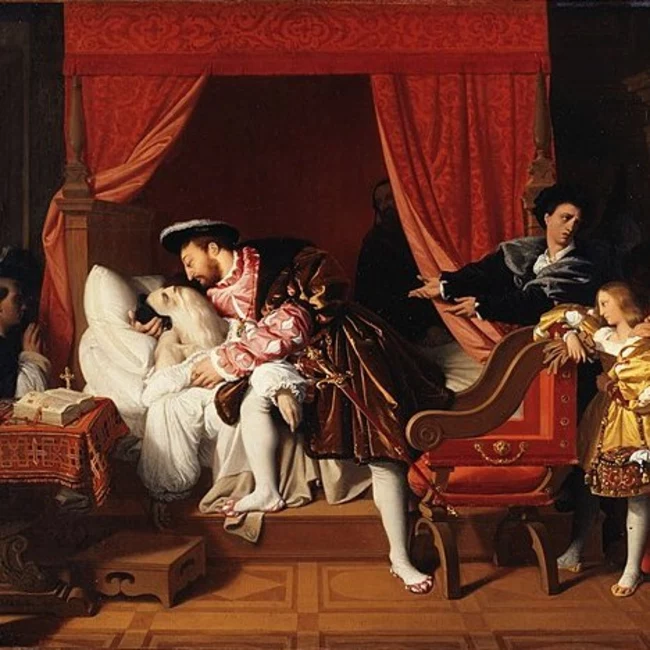
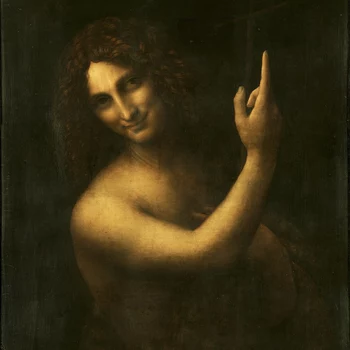
![[Translate to english:] [Translate to english:]](/fileadmin/_processed_/7/0/csm_anna-selbdritt_370c8646a0.webp.pagespeed.ce.NuSK1feNeY.webp)
![[Translate to english:] [Translate to english:]](/fileadmin/_processed_/4/8/csm_giorgio-vasaris-biografie-ueber-leonardo-da-vinci_5d12ee589b.webp.pagespeed.ce.be8yQGCZYc.webp)
![[Translate to english:] [Translate to english:]](/fileadmin/_processed_/1/2/csm_war-leonardo-da-vinci-schwul_194272ff8d.webp.pagespeed.ce.IG-OHSWppt.webp)